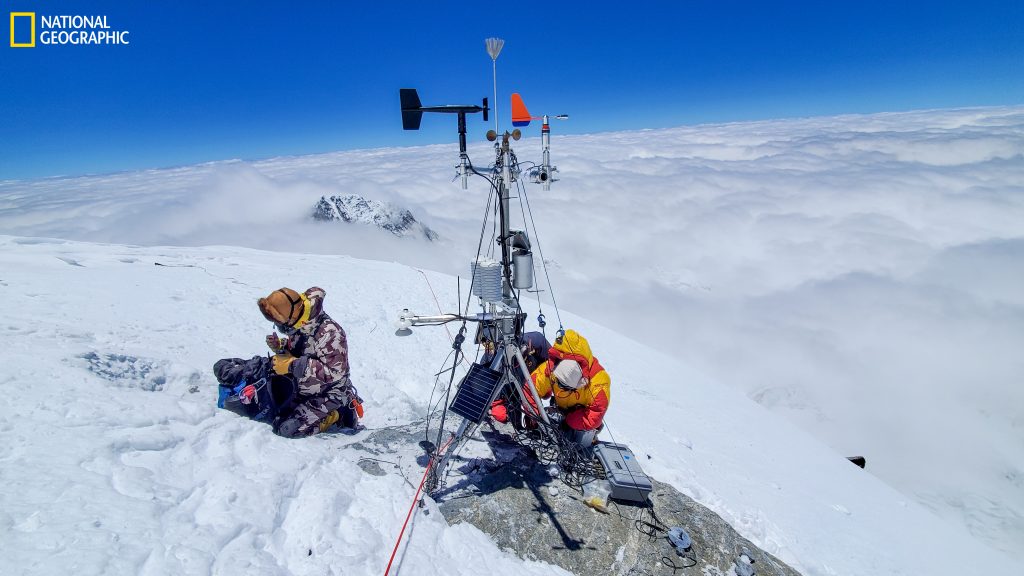

Setting the Bar High
Arklay S. Richards Company Inc. ‘s wind instruments have a long history of withstanding the test of time and the varying forces of mother nature. From underground mines to towering cranes, Richards’s wind instruments are designed for optimal performance in the harshest of environments. Each instrument is precision machined with the utmost attention to detail by a team who strives for manufacturing excellence. The Richards C5C Series Stainless Steel and Titanium Three-Cup Industrial Anemometer and the D5C Series Industrial Wind Direction Vane were featured in the National Geographic and Rolex Perpetual Planet Expedition as key installments on the world’s highest weather station system. With wind speeds frequently exceeding 100 miles per hour for more than 100 days per year, durability is imperative for the conditions on the summit of Mount Everest.
In the spring of 2022, Tenzing Gyalzen Sherpa, Tom Matthews, Baker Perry, and additional team members embarked on a trip to a predetermined site on Mt Everest called Bishop Rock. As mentioned in the Bulletin of the American Meteorological Society or BAMS article within the American Meteorological Society, this location would soon be home to, “the world’s highest weather station network on Everest” (Matthews et al., 2022). The expedition was also featured in the 2023 Guinness World Record News, sharing the details of the installment’s height. Bishop Rock is located 128 feet (39 meters) below the summit of Mount Everest at 28,904 feet (8,810 meters) (Atwal, 2023) above sea level.
The team would be transporting the parts to assemble a new weather station which would collect live weather data viewable by helicopter pilots and rescuers. The weather data would be used to plan future expeditions and assist emergency responders if a climber needed to be rescued. The Richards wind instruments would be key components of the Bishop Rock weather station wind speed and direction data designated to safeguard the climbers of Mount Everest.
National Geographic highlighted that wind speeds of 45 miles per hour and a windchill of -40 degrees Fahrenheit hit Bishop Rock at 9:00am on May 9th, 2022, when the team reached the designated site (2022). With temperature and winds of that capacity, frostbite was inevitable. To combat the harsh conditions during the setup process, the team members’ suits each contained a 24-volt battery that would generate heat. These batteries were crucial to install the unit’s anchor bolts. The team spent three hard-working hours setting up the new weather station. When the team made it back to South Col, they noted that data was already viewable to them, as climate data at Bishop Rock was being collected and received from the station during their descent.
South Col is located on the saddle or gap of the ridge between the summits of Mount Everest and Lhotse which is the fourth-highest mountain on Earth and is 27939 feet (8516 meters) above sea level. South Col is also a dangerous place situated at an elevation of 25938 feet (7906 meters). A second critical weather station was installed at South Col which also incorporates a Richards C5C Series Industrial Anemometer and a D5C Series Industrial Wind Direction Vane to provide reliable wind speed and direction data.
While the weather data is set to make a positive impact on the climbing community, this information is also vital in determining the impact of climate change on glaciers. The weather instruments will assist in gauging how atmospheric changes influence the snow and ice coverage on the mountain. An article from CNN discussed how more than a billion people depend on Mount Everest’s supply of fresh water (Gray, 2022). The team hopes that with additional weather station data, they can create a more accurate forecast model which will determine glacier runoff and a prognosis of future water trajectory.
With durability to withstand the environmental forces of both Mount Everest and South Col, and reliability to produce essential wind speed and direction data, the Arklay S. Richards Company continues to set the bar high for engineering and manufacturing the finest wind sensors available today.
